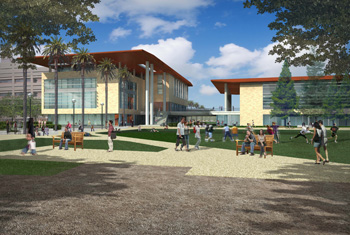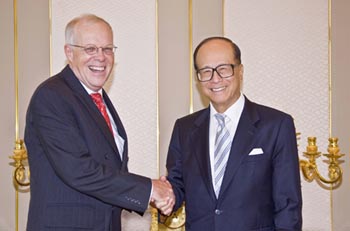For photos, please click here.

with support from Li Ka-shing
(29 April 2008) Stanford University's vision to create a School of Medicine unparalleled in scope and innovation takes another step as construction begins on the US$90 million Li Ka Shing Center for Learning and Knowledge. The Center will be named after its major benefactor, Hong Kong entrepreneur Li Ka-shing, a long-time supporter of Stanford University and the School of Medicine since the 1980s.
The purpose of the Center will be to provide wide-ranging opportunities for all members of the campus community - from students to emeritus faculty - to learn and exchange ideas. The Center will provide a supportive environment for the school's new curriculum and transform how students learn by offering state-of-the-art, interactive, experiential and team-based learning opportunities.
"The Li Ka Shing Center for Learning and Knowledge will be transformative for the School of Medicine and unique in the world," said Philip Pizzo, MD, dean of the medical school. "It will serve as valuable training ground for students throughout the university and medical center and a gathering place for our local and global community. We are deeply indebted to Mr Li for his devotion and commitment to education and for his wonderful support for the School of Medicine that enables us to provide a global resource for medicine and science education."
Mr Li became involved because he shares the school's goal of creating curriculum that will assist in transferring medical knowledge, crucial to supporting and developing the life sciences. A strong believer in synergy, Mr Li anticipates that the project will encourage collaboration with many other academic and professional disciplines.
"I am pleased to continue our support of Stanford University, particularly with these innovative approaches of combining medical education with multi-dimensional simulation experience," said Mr Li. "It is wonderful that the Learning and Knowledge Center, being the most technologically advanced teaching and learning center on the Stanford campus, will bring about an important paradigm shift in medical training that offers cross disciplines support for the developing life-science era."
This is Mr Li's third major project in support of Stanford University. Mr Li began making contributions through his charitable foundations in 1980 to foster a culture of giving in Asia where there is little or no government tax-relief structure as yet gearing towards supporting a culture of giving. He calls for Asians to transcend beyond the traditional values that see wealth and means pass through lineage as an imperative duty but should instead choose to apportion their wealth as social capital to engineer positive change as if it is their duty towards their children.
Mr Li, Chairman of Cheung Kong (Holdings) Limited and Hutchison Whampoa Limited, considers his charitable foundations to be his "third son", and has pledged to donate one-third of his assets to them. To date, Mr Li's charitable foundations have supported numerous charitable activities with grants, sponsorships and commitments of more than USD1.1 billion.
Innovative in its Scope
The Li Ka Shing Center will fulfill both of Mr Li's priorities by providing the most advanced, innovative education to those who will eventually use that knowledge to help and teach others.
The Center incorporates many unique features, including a state-of-the-art Center for Immersive and Simulation-based Learning that is believed to be one of the most comprehensive in the country. The immersive learning center will include a simulated operating room, intensive care unit and emergency room with mannequins that breathe and bleed, enabling students to experience the complex clinical world first-hand.
The Center will feature other innovative technologies, such as a virtual reality facility where students can view 21st Century anatomy technology, including a skull that rotates in space to reveal various parts of the brain. Large, high-resolution display walls in the classrooms will allow students to view small molecules or tissues in widely expanded views on a screen.
The building also will house the latest information technology and flexible classrooms, allowing students greater mobility and opportunities to work in teams. The new building will be equipped with three lecture halls, including one for team-based learning, and a 350-seat conference center for major functions.
Ground-breaking Ceremonies
More than 600 alumni, faculty and friends attended a groundbreaking for the project held at the school's Centennial dinner on 25 April. This year marks the 100th anniversary of the school's founding in San Francisco in 1908. The school moved to Palo Alto in 1959 and has occupied the same, aging buildings since that time.
To mark the start of construction on the new education center, dinner celebrants signed a white-painted steel beam that will help anchor the top floor. Major contributors to the project were among the first to sign the beam using memorial pens designed for the ceremonial signing.
The structure will be constructed on Campus Drive on the site of the former Fairchild Auditorium. The school hopes to complete the building by the spring of 2010, said project coordinator Maggie Saunders. The building was designed by the San Francisco office of the international architectural firm NBBJ.
 Download (4,054 KB) |
|
|
 Download (872 KB) |
|
Mr Li Ka-shing (right) in Hong Kong. |
About the Li Ka Shing charitable foundations
For almost three decades, Mr Li Ka-shing's charitable foundations have sought to enhance the impact of their philanthropy through two strategic objectives: to nurture a culture of giving and to foster creativity, constructive engagement, and sustainability through supporting capacity empowerment focused projects. Mr Li Ka-shing's charitable foundations have supported grants, sponsorships, and commitments of over HKD8.7 billion.
For further information, please visit: www.lksf.org
For media enquiries, please contact:
Ruthann Richter
Stanford University School of Medicine
Tel: (650) 725-8047
Fax: (650) 723-7172
Email: richter1@stanford.edu
Jeremy Lau
Li Ka Shing Foundation
Tel: (852)2128-1207
Fax: (852)2128-1766
Email: jeremyl@hwl.com.hk